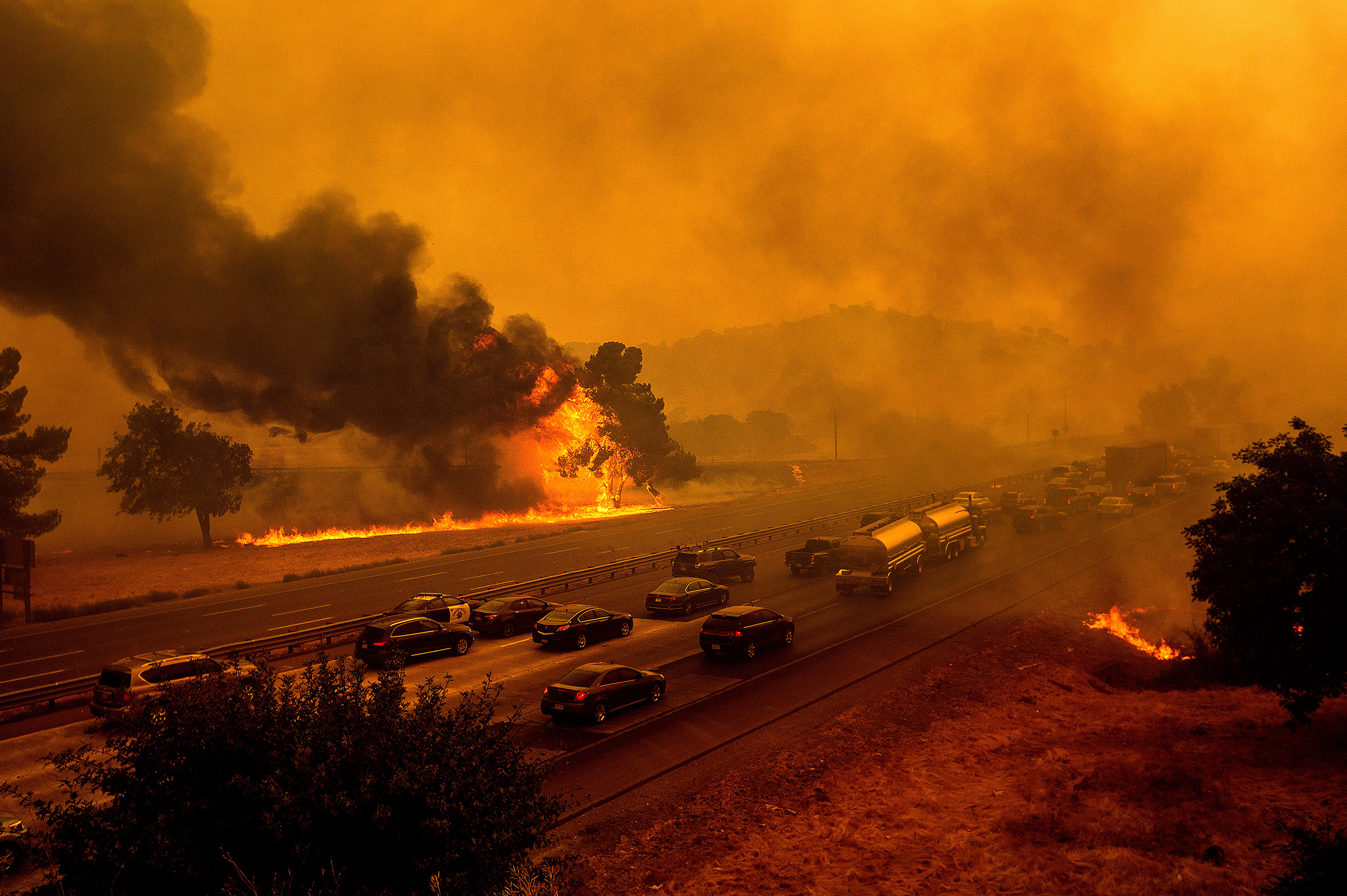Imagine Massachusetts on fire, literally the entire state engulfed in flames. That is how much land has already been ravaged—at least 5 million acres—in the wildfires of California, Washington and Oregon. Put another way, in just a few weeks these fires have burned as much land as was destroyed by a decade of using napalm and Agent Orange during the Vietnam War. With temperatures over 100°F, toxic air now blankets tens of millions of people, power outages have afflicted vast regions, and dozens have already died from the blazes. Air quality in West Coast cities has ranked among the world’s worst, with Portland’s air at points being almost three times more unhealthy than in notoriously polluted cities like New Delhi. The scenes of red skies out of America’s West have an unreal quality to them, as if they come from a different planet. In a sense they do—they are portents of the future.
There are many proximate reasons for these forest fires—fireworks, campfires, a stray spark—but there is one large cause that is blindingly clear: human actions that have led to climate change. To put it simply, the world is getting hotter, and that means that forests get drier. A yearslong drought, which ended in 2017, killed 163 million trees in California—and that deadwood proved to be the kindling for this year’s devastation. A scientific study led by Stanford, released in April, found that California’s five worst wildfires—whether measured by deaths, destruction or size—all occurred during 2017 and 2018. And we can be sure of one thing: it’s going to get worse. Temperatures continue to rise, drought conditions are worsening, and the combined effect of all these forces will multiply to create cascading crises in the years to come.
Cascades, in which small sparks cause great conflagrations, are happening all around us. Think of COVID-19, which began with a viral speck that was likely lodged in a bat somewhere in China—and is now a raging global pandemic. While viruses have been around forever, they mostly originate in animals and, when they jumped to humans, remained largely local. But over the past few decades, many viruses have gone global, causing widespread epidemics—SARS, MERS, Ebola, Zika and now the novel coronavirus. In a recent essay in the scientific journal Cell, the country’s top infectious—disease expert, Anthony Fauci, and one of his colleagues, David Morens, warn that we “have reached a tipping point that forecasts the inevitability of an acceleration of disease emergences.” In other words, get ready for more pandemics. The fundamental reason behind this acceleration, they argue, is human action—the ever increasing scope and pace of development.
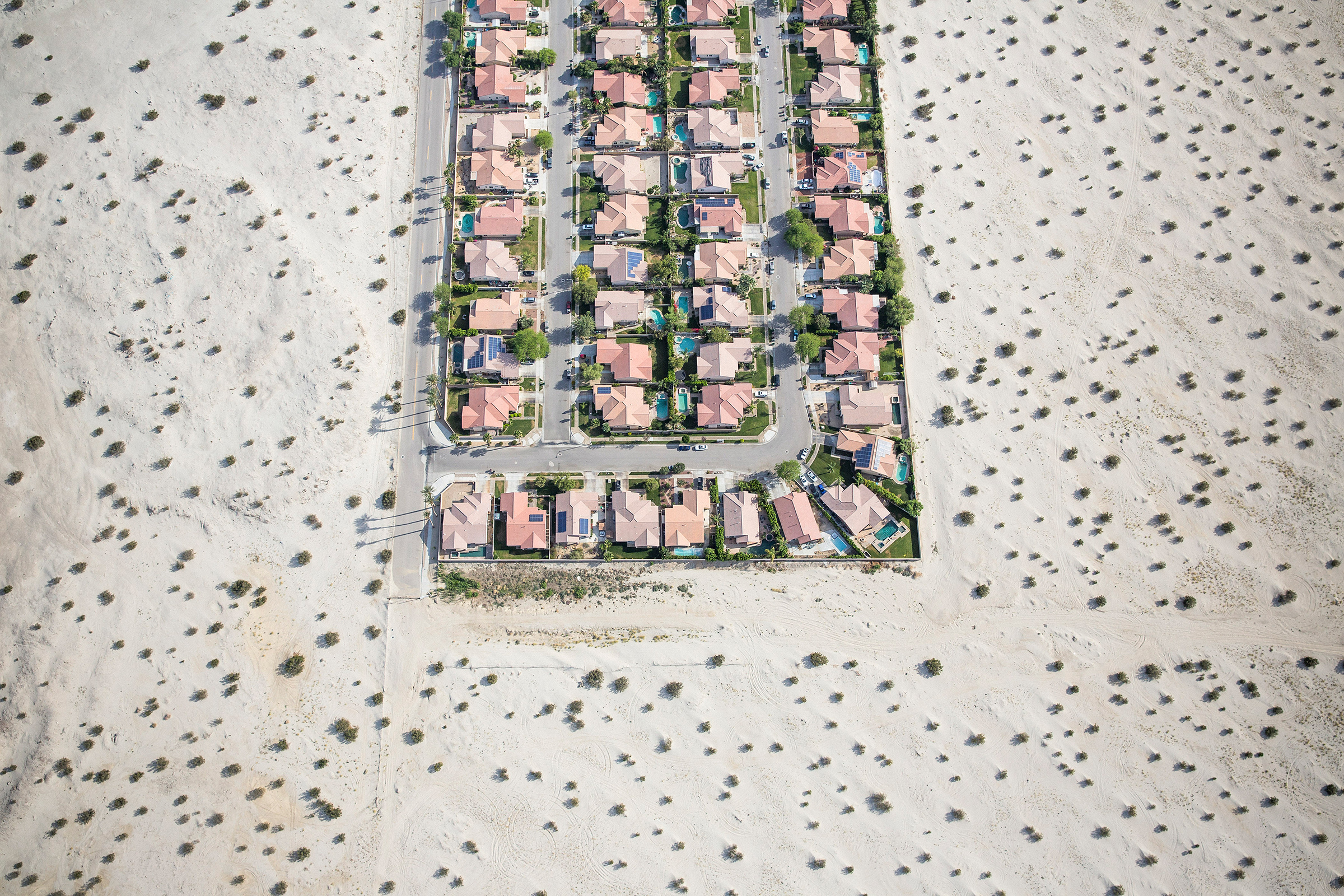
We have created a world in overdrive. People are living longer, producing and consuming more, inhabiting larger spaces, consuming more energy, and generating more waste and greenhouse gas emissions. The pace has accelerated dramatically in the past few decades. Just one example: a 2019 U.N. report, compiled by 145 experts from 50 countries, concluded that “nature is declining globally at rates unprecedented in human history.” It noted that 75% of all land has been “severely altered” by human actions, as has 66% of the world’s marine environments. Ecosystems are collapsing, and biodiversity is disappearing. As many as 1 million plant and animal species (of 8 million total) are threatened with extinction, some within a few decades. All these strains and imbalances produce dangers—some that can be foreseen, and others that cannot.
The pandemic, for its part, can be thought of as nature’s revenge. The way we live now is practically an invitation for animal viruses to infect humans. Why do diseases seem to be jumping from animals to humans at a faster pace in recent decades? As cities expand, they bring humans closer and closer to the habitat of wild animals, making it more likely that virus in a bat could be transmitted to a pig or a pangolin and then to humans. Developing countries are modernizing so quickly that they effectively inhabit several different centuries at the same time. In Wuhan and other such cities, China has built an advanced, technologically sophisticated-economy—but in the shadows of the skyscrapers are wildlife markets full of exotic animals, a perfect cauldron for animal-to-human viral transfer. And the people who live in these places are more mobile than ever before, quickly spreading information, goods, services—and disease.
Our destruction of natural habitats may also be to blame. Some scientists believe that as humans extend civilization into nature—building roads, clearing land, constructing factories, excavating mines—we are increasing the odds that animals will pass diseases to us. COVID-19 appears to have originated in bats, which are hosts to many other viruses, including rabies and Ebola. Bats used to live farther from humans. But as we encroached on their habitats, their diseases increasingly became our diseases. “We are doing things every day that make pandemics more likely,” said Peter Daszak, an eminent disease ecologist. “We need to understand, this is not just nature. It is what we are doing to nature.”
As economic development moves faster and reaches more people, we are taking ever greater risks, often without even realizing it. Think about meat consumption. As people get richer, they eat more meat. When this happens globally, the effect is staggering: about 80 billion animals are slaughtered for meat every year around the world. (And that doesn’t even count fish.) But supplying this enormous demand comes at great cost to the environment and our health. Animal products provide only 18% of calories worldwide yet take up 80% of the earth’s farmland. Meanwhile, meat is now produced on a vast scale with animals packed together in gruesome conditions. Most livestock—an estimated 99% in America, 74% around the world—comes from factory farms. (Organically farmed, grass-fed meat is a luxury product.) These massive operations serve as petri dishes for powerful viruses. “Selection for specific genes in farmed animals (for desirable traits like large chicken breasts) has made these animals almost genetically identical,” Vox journalist Sigal Samuel explains. “That means that a virus can easily spread from animal to animal without encountering any genetic variants that might stop it in its tracks. As it rips through a flock or herd, the virus can grow even more virulent.” The lack of genetic diversity removes the “immunological firebreaks.”
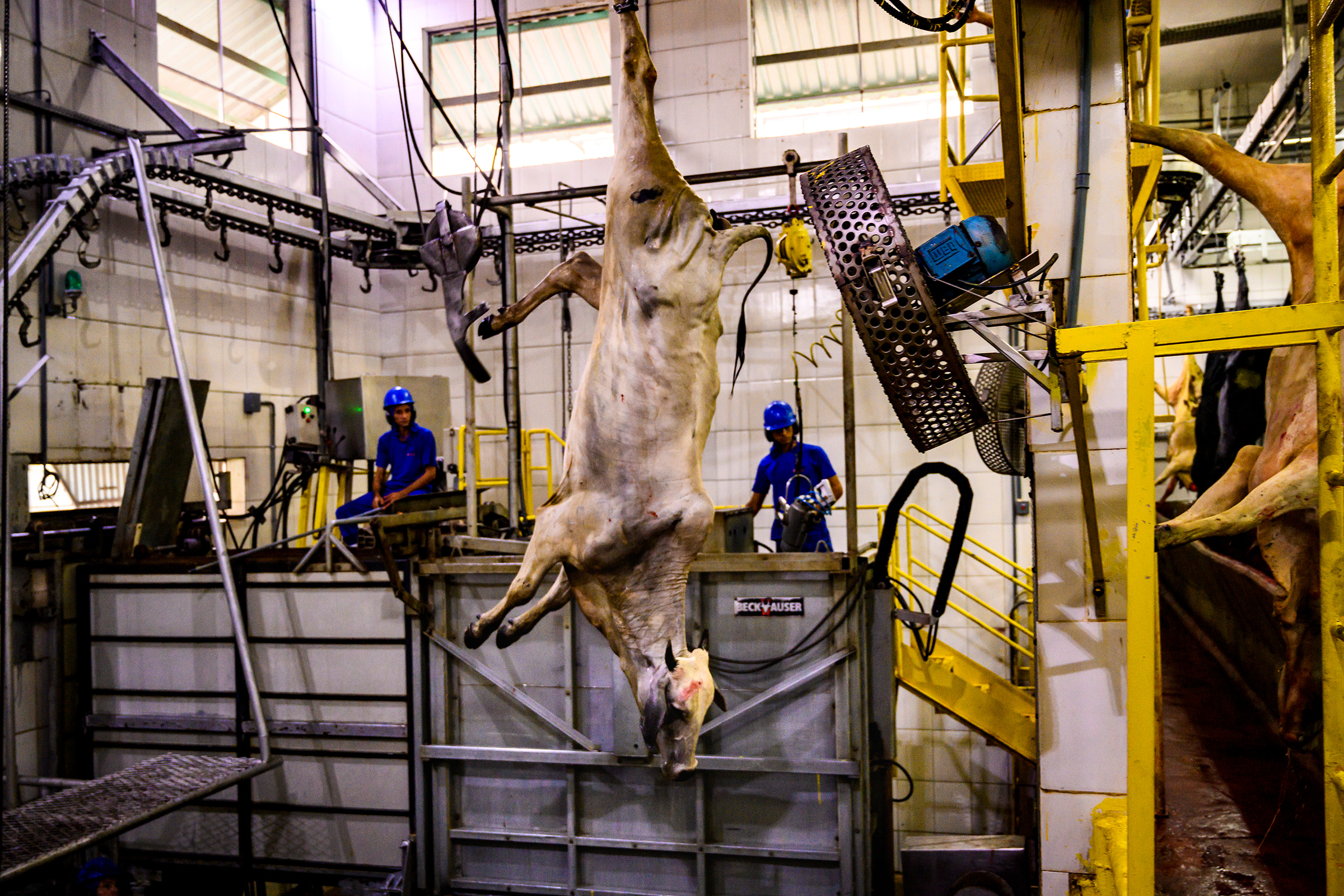
Americans should know better. The country has experienced several ecological disasters, most notably the 1930s Dust Bowl. The event is seared in the American imagination. The bitter tale of desperate Dust Bowl migrants inspired John Steinbeck’s Grapes of Wrath—describing the plight of people who could be called America’s first climate refugees. And it is a story of human actions causing a natural reaction.
The Great Plains are the semiarid places east of the Rocky Mountains and west of the Mississippi River. The wind blows fast over these lands, sometimes scarily so. Over centuries, probably millennia, nature’s solution was to grow grass that held the loose topsoil in place. But by the late 19th century, as the pioneers headed west, lured by promises of fertile farmland, they tilled the prairies, turning the grassy plains into wheat fields. The farmers felled trees that served as windbreaks, and turned the soil over and over, until there was no grass and the topsoil had been reduced to a thin, loose layer just covering the hard land beneath.
Then came bad weather. Starting in 1930, the region was hit by four waves of drought. With the drought came winds—ferocious gales that blew off the entire layer of topsoil with a force that few humans had seen before and kicked up dust storms that blackened the sky. By 1934, the topsoil covering 100 million acres of land had blown away. The heat intensified the suffering—1934 was the nation’s hottest year on record until 1998. Thousands died and millions fled. The farmers left behind were plunged into a decade of poverty.
We are tempting fate similarly every day. We are now watching the effects of climate change on almost every part of the natural environment. It is bringing a warmer climate to more of the world, thus creating more hospitable conditions for disease. It is also turning more land into desert—23 hectares every minute, by the U.N.’s estimate. In 2010, Luc Gnacadja, who headed the organization’s effort to combat desertification, called it “the greatest environmental challenge of our time,” warning that “the top 20 centimeters of soil is all that stands between us and extinction.” Thirty-eight percent of the earth’s surface is at risk of desertification. Some of it is caused less by global climate change than by something more easily preventable: the overextraction of water from the ground. One of the world’s most crucial water sources is the Ogallala Aquifer, which sprawls through the Great Plains and supplies about a third of the groundwater used to irrigate American farms. This seemingly bottomless well is in fact being emptied by agribusiness so fast that it is on track to shrivel by 70% in less than 50 years. If the aquifer ran dry, it would take 6,000 years for rainfall to refill it.

You may say that this is not new. Human beings have been altering natural processes ever since they learned how to make fire. The changes picked up speed with the invention of the wheel, the plow and, most dramatically, the steam engine. But they intensified, particularly in the 20th century and in the past few decades. The number of people on the planet has risen fivefold since 1900, while the average life span has doubled. The increase in life span goes “beyond the scope of what had ever been shaped by natural selection,” explained Joshua Lederberg, the biologist who won the Nobel Prize at age 33 for his work on bacterial genetics. In a brilliant, haunting speech in 1989 at a virology conference in Washington, D.C., Lederberg argued that we have changed our biological trajectory so much that “contemporary man is a man-made species.”
Lederberg called human beings’ continued economic and scientific advancement “the greatest threat to every other plant and animal species, as we crowd them out in our own quest for lebensraum.” “A few vermin aside,” he added, “Homo sapiens has undisputed dominion.” But he pointed out that we do have one real competitor—the virus—and in the end, it could win. “Many people find it difficult to accommodate to the reality that nature is far from benign; at least it has no special sentiment for the welfare of the human vs. other species.” Lederberg reminded the audience of the fate that befell rabbits in Australia in the 1950s, when the myxoma virus was unleashed upon them as a population—control measure. Eventually, rabbits achieved herd immunity, but only after the virus had killed over 99% of those infected in the first outbreaks. He concluded his speech with a grim image: “I would … question whether human society could survive left on the beach with only a few percent of survivors. Could they function at any level of culture higher than that of the rabbits? And if reduced to that, would we compete very well with kangaroos?
This is a gloomy compendium of threats. And given the unstable nature of our international system, it may seem that our world is terribly fragile. It is not. Another way to read human history is to recognize just how tough we are. We have gone through extraordinary change at breathtaking pace. We have seen ice ages and plagues, world wars and revolutions, and yet we have survived and flourished. In his writings, Joshua Lederberg acknowledged that nature usually seeks an equilibrium that favors mutual survival of the virus and the host—after all, if the human dies, so does the parasite.
Human beings and our societies are amazingly innovative and resourceful. This planet is awe-inspiringly resilient. But we have to recognize the ever greater risks we are taking and act to mitigate them. Modern human development has occurred on a scale and at a speed with no precedent. The global system that we are living in is open and dynamic, which means it has few buffers. That produces great benefits but also vulnerabilities. We have to adjust to the reality of ever increasing instability—now.
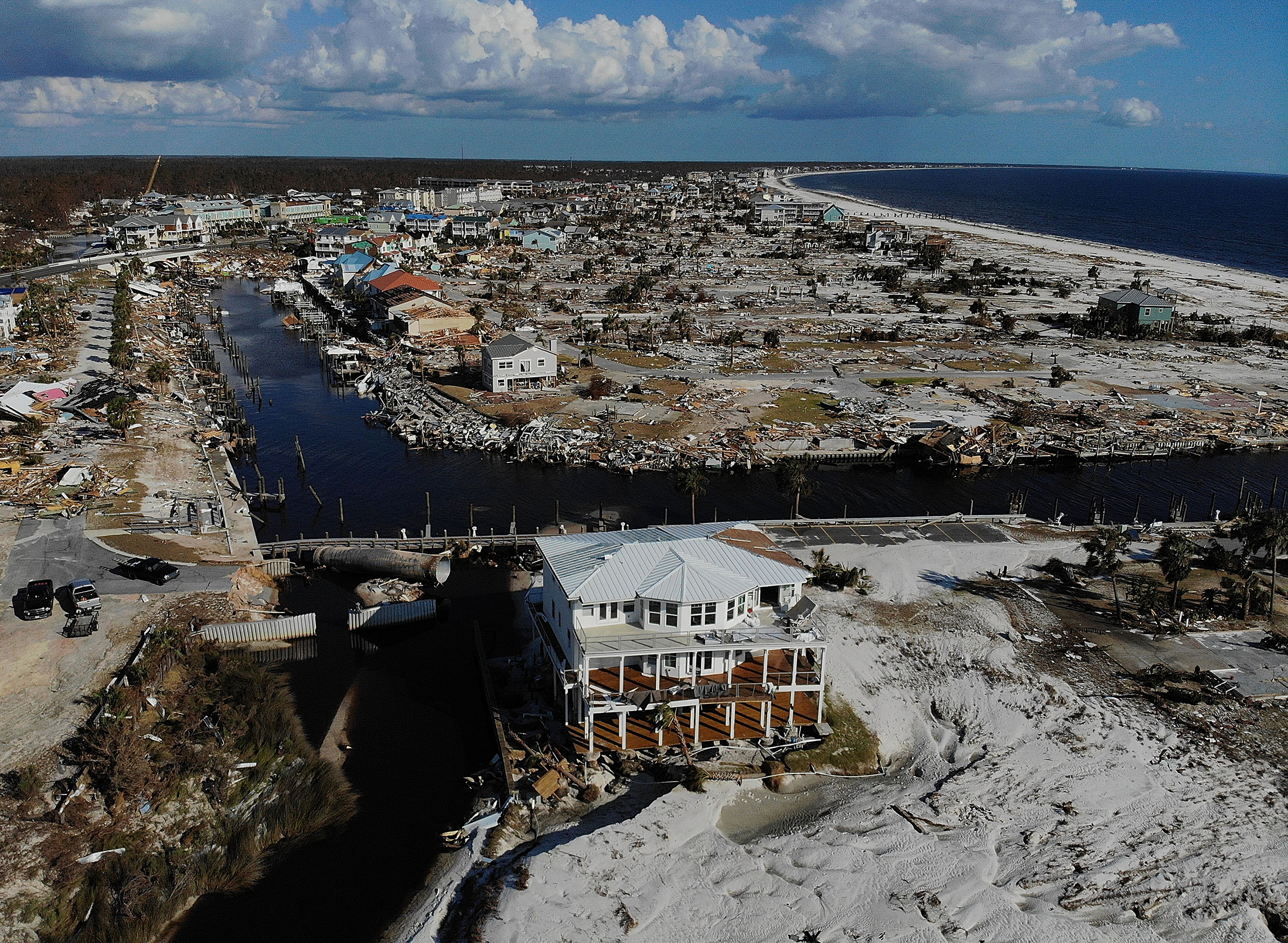
We are not doomed. The point of sounding the alarm is to call people to action. The question is, what kind of action? There are those, on the right and the left, who want to stop other countries from growing economically and shut down our open world. But should we tell the poorest billion in the world that they cannot escape poverty? Should we close ourselves off from the outside world and seek stability in national fortresses? Should we try to slow down technology, or the global movement of goods and services? Even if we wanted to do any of this, we would not be able to arrest these powerful forces. We could not persuade billions of people to stop trying to raise their standards of living. We could not prevent human beings from connecting with one another. We could not stop technological innovation. What we can do is be far more conscious of the risks we face, prepare for the dangers and equip our societies to be resilient. They should be able not only to withstand shocks and backlashes, but also learn from them. Nassim Nicholas Taleb suggests that we create systems that are “anti-fragile,” which are even better than resilient ones. They actually gain strength through chaos and crises.
We know what to do. After the Dust Bowl, scientists quickly understood what had happened. Franklin D. Roosevelt’s Administration produced a short movie to explain it to the country, The Plow That Broke the Plains. Government agencies taught farmers how to prevent soil erosion. The Administration provided massive aid to farmers, established the Soil Conservation Service and placed 140 million acres of federal grasslands under protection. In the past three-quarters of a century, there has been no second Dust Bowl, despite extreme weather.
“Outbreaks are inevitable, but pandemics are optional,” says Larry Brilliant, the American physician who helped eradicate smallpox 45 years ago. What he means is that we may not be able to change the natural occurrences that produce disease in the first place, but through preparation, early action and intelligent responses, we can quickly flatten its trajectory. In fact, the eradication of smallpox is a story that is only partly about science and mostly about extraordinary cooperation between rival superpowers and impressive execution across the globe.
Similarly, climate change is happening, and we cannot stop it completely. But we can mitigate the scale of change and avert its most harmful effects through aggressive and intelligent policies. It will not be cheap. To address it seriously we would need to start by enacting a carbon tax, which would send the market the right price signal and raise the revenue needed to fund new technologies and simultaneously adapt to the already altered planet. As for economic development, there are hundreds of ways we could approach the process differently, retaining traditional ingredients like growth, openness and innovation while putting new emphasis on others like security, resilience and anti-fragility. We can make different trade-offs, forgo some efficiencies and dynamism in some areas, and spend more money to make our societies prepared. The costs of prevention and preparation are minuscule compared with the economic losses caused by an ineffective response to a crisis. More fundamentally, building in resilience creates stability of the most important kind, emotional stability. Human beings will not embrace openness and change for long if they constantly fear that they will be wiped out in the next calamity.
And what about preventing the next pandemic? Again, we need to balance dynamism with safety. Much attention has focused on wet markets where live animals are slaughtered and sold, but these cannot simply be shut down. In many countries, especially in Africa and Asia, they provide fresh food for people who don’t own refrigerators. (In China, they account for 73% of all fresh vegetables and meat sold.) These markets should be better regulated, but they pose limited risks when they do not sell wild animals like bats, civets and pangolins. It is that exotic trade that must be outlawed. Similarly, getting the world to stop eating meat may be impossible, but promoting healthier diets—with less meat—would be good for humans and the planet. And factory farming can be re-engineered to be much safer, and far less cruel to animals. Most urgently, countries need strong public-health systems, and those systems need to communicate, learn from and cooperate with one another. You cannot defeat a global disease with local responses.
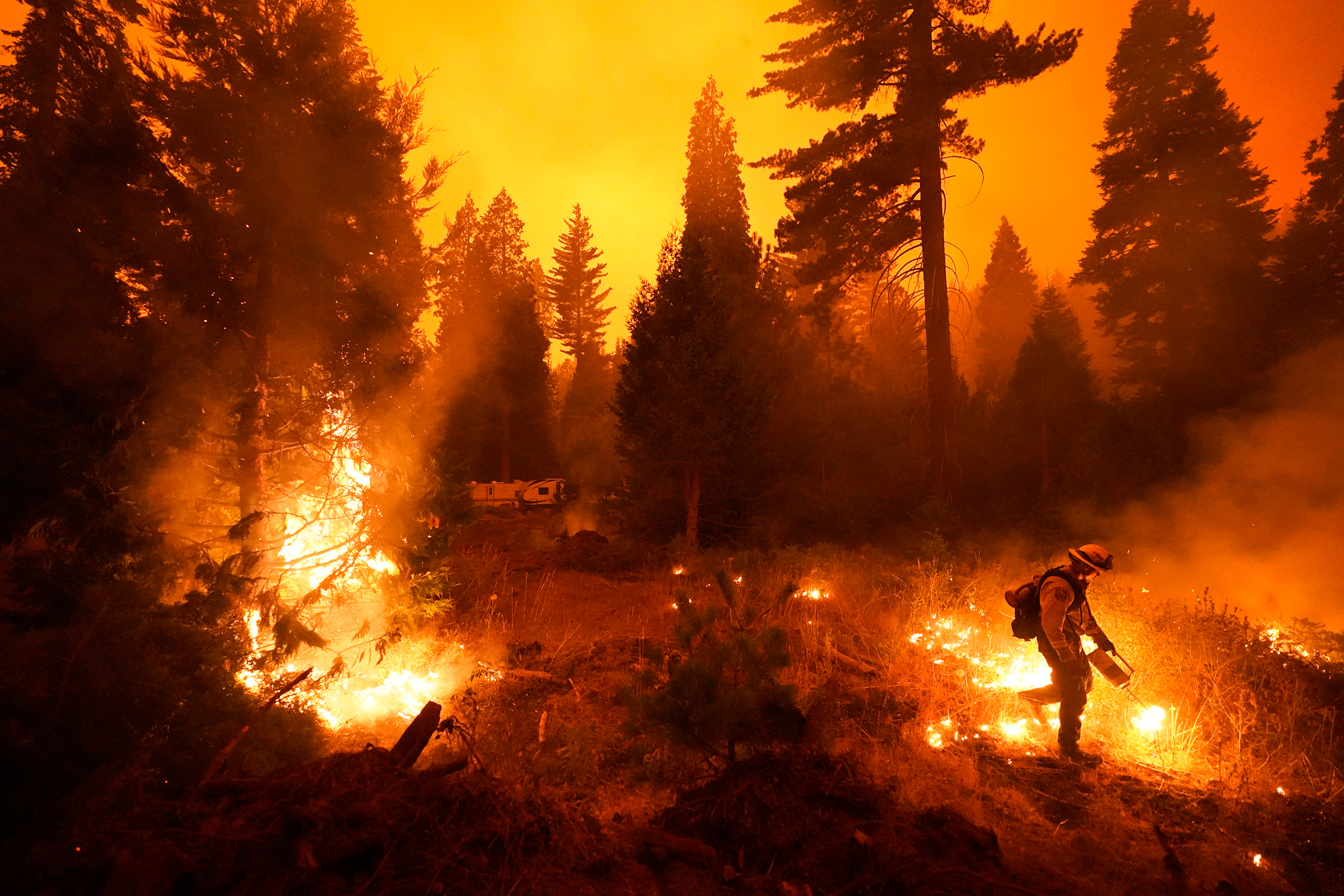
So too California can’t stop climate change or wildfires alone. But, like America after the Dust Bowl, it can learn from its policy mistakes, using controlled burns to clear out underbrush and practicing sustainable construction. Unfortunately, earlier this month it took a step in the wrong direction when lawmakers killed a reform bill that would have allowed denser housing development. Without new action, single-family homes will keep sprawling outward into the forest, expanding the human footprint and making future destructive fires inevitable. Rather than subsidizing settlements on the coastline and in forests and deserts, governments should encourage housing in safe and more sustainable areas. We have to recognize that the way we are living, eating and consuming energy are all having an impact on the planet—and increasingly it is reacting.
Human beings have been developing their societies at an extraordinary pace, expanding in every realm at unprecedented speed. It is as if we have built the fastest race car ever imagined and are driving it through unknown, unmarked terrain. But we never bothered to equip the car with airbags. We didn’t get insurance. We have not even put on our seat belts. The engine runs hot. Parts overheat and sometimes even catch fire. There have been some crashes, each one a bit worse than the last. So we douse the vehicle, tune up the suspension, repair the bodywork and resolve to do better. But we race on, and soon we are going faster and faster, into newer and rougher terrain. It’s getting very risky out there. It’s time to install those airbags and buy some insurance. And above all, it’s time to buckle up.
This essay is adapted from TEN LESSONS FOR A POST-PANDEMIC WORLD. Copyright (c) 2020 by Fareed Zakaria. Published by W. W. Norton & Company, Inc. All rights reserved.
Correction, Oct. 5
The original version of this story misstated what Anthony Fauci and David Morens wrote in Cell about disease outbreaks. They wrote that we have “reached a tipping point that forecasts the inevitability of an acceleration of disease emergences,” not “an acceleration of disease emergencies.”
More Must-Reads from TIME
- Cybersecurity Experts Are Sounding the Alarm on DOGE
- Meet the 2025 Women of the Year
- The Harsh Truth About Disability Inclusion
- Why Do More Young Adults Have Cancer?
- Colman Domingo Leads With Radical Love
- How to Get Better at Doing Things Alone
- Michelle Zauner Stares Down the Darkness
Contact us at letters@time.com
